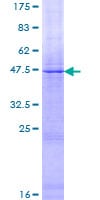Recombinant Human Factor VIII protein (ab158403)
Key features and details
- Expression system: Wheat germ
- Tags: GST tag N-Terminus
- Suitable for: WB, ELISA
-
Product name
Recombinant Human Factor VIII protein -
Expression system
Wheat germ -
Accession
-
Protein length
Full length protein -
Animal free
No -
Nature
Recombinant -
-
Species
Human -
Sequence
MRIQDPGKVFFGNVDSSGIKHNIFNPPIIARYIRLHPTHYSIRSTLRMEL MGCDLNSCSMPLGMESKAISDAQITASSYFTNMFATWSPSKARLHLQGRS NAWRPQVNNPKEWLQVDFQKTMKVTGVTTQGVKSLLTSMYVKEFLISSSQ DGHQWTLFFQNGKVKVFQGNQDSFTPVVNSLDPPLLTRYLRIHPQSWVHQ IALRMEVLGCEAQDLY -
Predicted molecular weight
51 kDa including tags -
Amino acids
1 to 216 -
Tags
GST tag N-Terminus -
Additional sequence information
Full length protein for Isoform 2 of Factor VIII. Also known as: F8B.
-
Preparation and Storage
-
Alternative names
- AHF
- Antihemophilic factor
- Coagulation factor VIII
see all -
Function
Factor VIII, along with calcium and phospholipid, acts as a cofactor for factor IXa when it converts factor X to the activated form, factor Xa. -
Involvement in disease
Defects in F8 are the cause of hemophilia A (HEMA) [MIM:306700]. A disorder of blood coagulation characterized by a permanent tendency to hemorrhage. About 50% of patients have severe hemophilia resulting in frequent spontaneous bleeding into joints, muscles and internal organs. Less severe forms are characterized by bleeding after trauma or surgery. Note=Of particular interest for the understanding of the function of F8 is the category of CRM (cross-reacting material) positive patients (approximately 5%) that have considerable amount of F8 in their plasma (at least 30% of normal), but the protein is non-functional; i.e., the F8 activity is much less than the plasma protein level. CRM-reduced is another category of patients in which the F8C antigen and activity are reduced to approximately the same level. Most mutations are CRM negative, and probably affect the folding and stability of the protein. -
Sequence similarities
Belongs to the multicopper oxidase family.
Contains 3 F5/8 type A domains.
Contains 2 F5/8 type C domains.
Contains 6 plastocyanin-like domains. -
Domain
Domain F5/8 type C 2 is responsible for phospholipid-binding and essential for factor VIII activity. -
Post-translational
modificationsSulfation on Tyr-1699 is essential for binding vWF. -
Cellular localization
Secreted > extracellular space. - Information by UniProt






